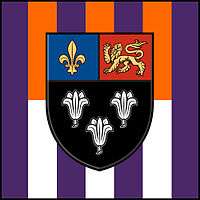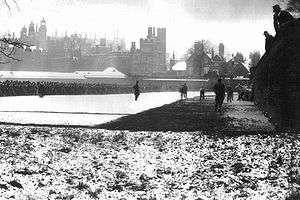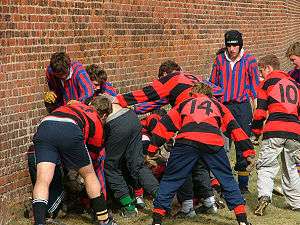Eton wall game

The Eton wall game is a game which bears some resemblance to rugby union that originated at and is still played at Eton College. It is played on a strip of ground 5 metres wide and 110 metres long ("The Furrow") next to a slightly curved brick wall ("The Wall") erected in 1717.
The traditional and most important match of the year is played on St Andrew's Day, as the Collegers (King's Scholars) take on the Oppidans (the rest of the school). Although College has only 70 boys to pick from, compared to the 1250 or so Oppidans, the Collegers have one distinct advantage: access to the field on which the Wall Game is played is controlled by a Colleger. Despite this, it is usual for them to allow the Oppidans to use it whenever they wish.

At the annual St Andrew's Day match, the Oppidans climb over the wall, after throwing their caps over in defiance of the Scholars, while the Collegers march down from the far end of College Field, arm-in-arm, towards the near end, where they meet the Oppidans.
The Wall Game is also played on Ascension Day, immediately after a 6 a.m. service on the roof of College Chapel.[1] Various scratch matches are also played throughout the Michaelmas and Lent halves (terms), where boys from different year groups, as well as masters, take part.
Scoring
The aim of the game is to move the ball towards the opponents' end of the playing area. In those last few yards of the field is an area called the "calx". In this area a player can earn a "shy" (worth one point) by lifting the ball against the wall with his foot. A teammate then touches the ball with his hand and shouts "Got it!" These two plays must happen within the calx. After this, if the umpire says "Given", the scoring team can attempt a goal (worth a further nine points) by throwing the ball at a designated target (a garden door at one end of the field and a tree at the other end). A player can also score a kicked goal, worth five points, if he kicks the ball out and it hits a goal during the normal course of play.
Play

The main game consists of the two sets of players forming a rugby-style scrummage (called a "Bully") in which neither team may "furk" the ball, which is to hook it backwards (except in Calx, where a different type of Bully called a Calx Bully occurs). The Bully is formed next to the Wall and crabs slowly along the Wall until the ball emerges. Many players, particularly those whose position is actually against the Wall, lose the skin off their elbows, hips and knees. Because of this, players usually wear long sleeves. Players within the Bully shove and push each other, mostly with their bodies but also by placing their fists against the faces of the opposition and attempting to lever them backwards and away from the Wall. Actual punching is not permitted, and grabbing an opponent's shirt ("holding") is also not allowed.
The fastest way to make ground is by kicking the ball upfield and out of play whenever it comes sideways out of the Bully; unlike most types of football, play is restarted opposite where the ball stops after it had gone out, or was touched after it had gone out.
Consequently, the most common tactic revolves around the formation of a 'phalanx'. This consists of a tunnel (coming out from the wall, diagonally forward from the position of the ball) of players from one team who are crouching on hands and feet next to each other. Once the team in possession of the ball has formed a successful phalanx, it attempts to pass the ball down the 'tunnel' using the knees of the players forming it, to a player standing at the end of the phalanx (i.e. furthest away from the Wall), known as Lines, whose job it is to kick the ball upfield. The team not in possession is constantly attempting to disrupt this, and win the ball back.
The game lasts up to 55 minutes, with two halves of 25 minutes each and an additional 5 minutes as half-time break. Many games end 0-0. Goals (worth ten points) are very rare; they occur about once every 10 years, and no goals have been scored in the St Andrew's Day game since 1909. A goal was scored in a recent scratch match (a less formal warm-up match for the St Andrew's Day game) in May 2016 by a College player. However, shies (worth 1 point) are scored more frequently.
In the 2016 game, the 250th St. Andrew's Day match, College triumphed 1–0 against the Oppidans. This was the 107th consecutive St Andrew's Day match in which no goals were scored by either team; however, College scored a shy.
Organisation
The Wall Game is organised entirely by boys, particularly by the Keepers (captains) of College Wall, Oppidan Wall and Mixed Wall. Famous past players of the Wall Game include Boris Johnson, who was Keeper of the College Wall, George Orwell and Harold Macmillan. The First World War flying ace Arthur Rhys Davids also played, representing College with Ralph Dominic Gamble in 1915.
Members of the College Wall also annually commemorate the outstanding player and Keeper of the Wall Logie Leggatt, who was killed in the First World War at the age of 22, making a toast at each year's Christmas Sock Supper with the words in piam memoriam L.C.L (in affectionate memory of L.C.L). Despite its renown outside the school, only a very small number of the 250 or so boys in each year group ever take part in the sport, unlike the lesser-known but much more widely played Eton Field Game.
The Eton Wall Game has been played twice by all-female teams.
In popular culture
In 1948, the game was televised by the BBC. When shared by the BBC Archive on social media in 2017, it was described as "baffling", and the televising as "rubbish".[2]
The British sitcom Green Wing features a fictional game, Guyball (/ˈɡiːbɔːl/), which parodies the obscurity of public school pastimes such as the Eton wall game. It is introduced by Guy Secretan, who learned the sport at the fictional school Whiteleaf (/ˈhwɪtlɪf/). The object of the game is to throw balls in a "Topmiler", a wicker basket on top of a leather flying helmet. However, the rules of Guyball are never fully explained and are designed to be as confusing and as difficult to understand as possible. Fans of the show have however created their own rules, and the game was occasionally played 'for real'.
In Terry Pratchett's Discworld series, the Ankh-Morpork Assassins' Guild has a far more sadistic variant of the "Wall Game", and is essentially an extreme hybrid of rock-climbing and dodgeball.
In the first of Charlie Higson's Young Bond novels, SilverFin, the young James Bond comes to Eton and learns the rules of the Wall Game.
The game was a subject of the 1987 book, The Sports Hall of Shame, by Bruce Nash and Allan Zullo.
Robert Ludlum's novel The Bancroft Strategy briefly describes the game, saying "I believe the last time a goal was scored on a St. Andrew's day match was in 1909, if you can believe it."
Frederick Forsyth's novel The Cobra has a passing reference to the Wall Game.
Len Deighton's nameless protagonist in The IPCRESS File, in passing, compares the scene boarding an aeroplane to the Eton Wall Game.
See also
References
- ↑ British Pathe film on the Eton wall game
- ↑ Facebook. BBC Archive https://www.facebook.com/BBCArchive/videos/491679074538461/. Retrieved 3 December 2017. Missing or empty
|title=(help)